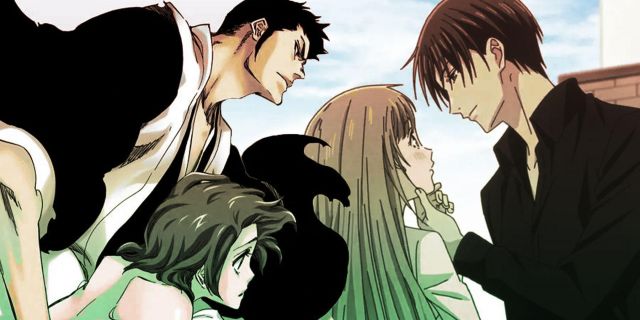Bleach is a shonen “big three” title, meaning it has themes of the power of friendship, getting stronger to defeat true evil and the sheer joy of adventure. Overall, Bleach has little in common with shojo anime, but a recent flashback may have reminded shojo fans of Fruits Basket and the story of how Tohru Honda’s parents met.
Ichigo and Tohru both have parents who met under unlikely circumstances, with the father wooing the younger mother and protecting her from harm. These are sweet romances, but despite being a shonen action series, Bleach actually has a better “how the parents met” romance than Fruits Basket does. That’s because Bleach’s supernatural combat system helped even the playing field.
When the Father Gallantly Saves the Mother & Finds Love in Anime

Bleach and Fruits Basket both have substantial flashback scenes, showing how their respective protagonists’ parents met. In each flashback, the father was somewhat older than the mother and saved her from serious trouble, and in the process, both couples fell in love, married and later had children. At a glance, this may seem unflattering to the mothers, depicting them as vulnerable people in need of rescue — the classic damsel-in-distress paradigm. True, the mothers needed rescue, but Bleach and Fruits Basket handled it differently, and the mothers are defined by more than their temporary peril.
To begin with, the respective fathers, then-Captain Isshin Shiba and the schoolteacher Katsuya Honda, were kind, selfless men who would sacrifice anything and make any effort to save someone who needed them. Katsuya comforted and supported the bitter delinquent Kyoko and turned her life around, and in Bleach, Isshin Shiba gave up his Soul Reaper powers and career to save Masaki from the deadly Hollow inside her. Before then, Isshin and Masaki both fought that Hollow with their respective powers, but only Isshin’s sacrifice could truly save Masaki and allow them to be together.
Kyoko Katsunuma, now Kyoko Honda, totally changed her ways and became a compassionate, optimistic and generous person as well as a devoted mother, passing on these uplifting traits to her daughter Tohru, especially after Katsuya’s death. Similarly, Masakai Kurosaki became Isshin’s passionate lover, and she inspired him with her radiant deredere personality. Isshin considered Masaki the sun, with his entire life revolving around her warmth.
Tragically, both anime moms died before their children started the main story, but Ichigo and Tohru both take after their mothers, sometimes in ways they didn’t expect. This is all thanks to their fathers stepping in as gallant heroes when their mothers needed them most. Personal stories like that transcend the divide of shonen, shojo, seinen and josei, proving that some themes are truly universal in their appeal and that the four anime demographics aren’t necessarily so different after all.
How Bleach Depicted a More Equal Relationship Than Fruits Basket

Overall, both parental pairs are somewhat unequal, as each father had to step in to save the mothers from their woes, which may reinforce troubling narrative trends that women must rely on men to save and protect them. This is much more pronounced in Fruits Basket, however, and many anime fans even view Katsuya Honda’s actions as a benign but clear form of grooming. He was stronger in every sense, being older, more successful and more mature. Kyoko was totally vulnerable and clung to him for dear life, and she had no other options. Katsuya didn’t say as much, but Kyoko had no choice but to be with him, and he spent years with the underaged Kyoko, building up their relationship until Kyoko was old enough to marry and have children. It’s functionally grooming, even if Katsuya had no malevolent intentions.
Meanwhile, Bleach’s Isshin-Masaki pairing is a bit skewed, but the story took steps to minimize that. For example, Masaki was not completely helpless, even if she needed Isshin’s aid with the inner Hollow. When she and Isshin met, they both used formidable spiritual powers to fight the strange Hollow called White. In fact, Masaki saved Isshin’s life with her arrows — a heroic action for which Isshin took great steps to repay her. Masaki was a true fighter, and even years later, as a mother, she was ready to use her Quincy powers to fight off Grand Fisher and defend a young Ichigo. Masaki only died because at the last moment, King Yhwach remotely stole her powers with Auswahlen, leaving her defenseless.
In addition, Isshin had a better personal dynamic with Masaki than Katsuya had with Kyoko. Masaki owed Isshin her life for containing her inner Hollow, but Isshin didn’t smother her, and Masaki didn’t rely entirely on Isshin to live her life. Aside from leaving the Ishida family residence, Masaki’s life was the same as ever, and she became Isshin’s best friend and girlfriend while still having an identity outside their relationship. She would merely visit Isshin at his clinic and flirt, and she even had a college career, needing no aid from Isshin for her education.
When she was good and ready, Masaki married Isshin, and they had three children together. They relied on each other while also respecting one another as equals, and Isshin never once asked Masaki to repay him for giving up his Soul Reaper powers to save her. In Isshin’s mind, they were even, and he looked up to his new wife as the sun in his sky and the reason he was now a happy family man rather than a fighter. Isshin believed he had traded up, and that’s the best compliment he could have paid his brave, kind Quincy wife.















Leave a Reply